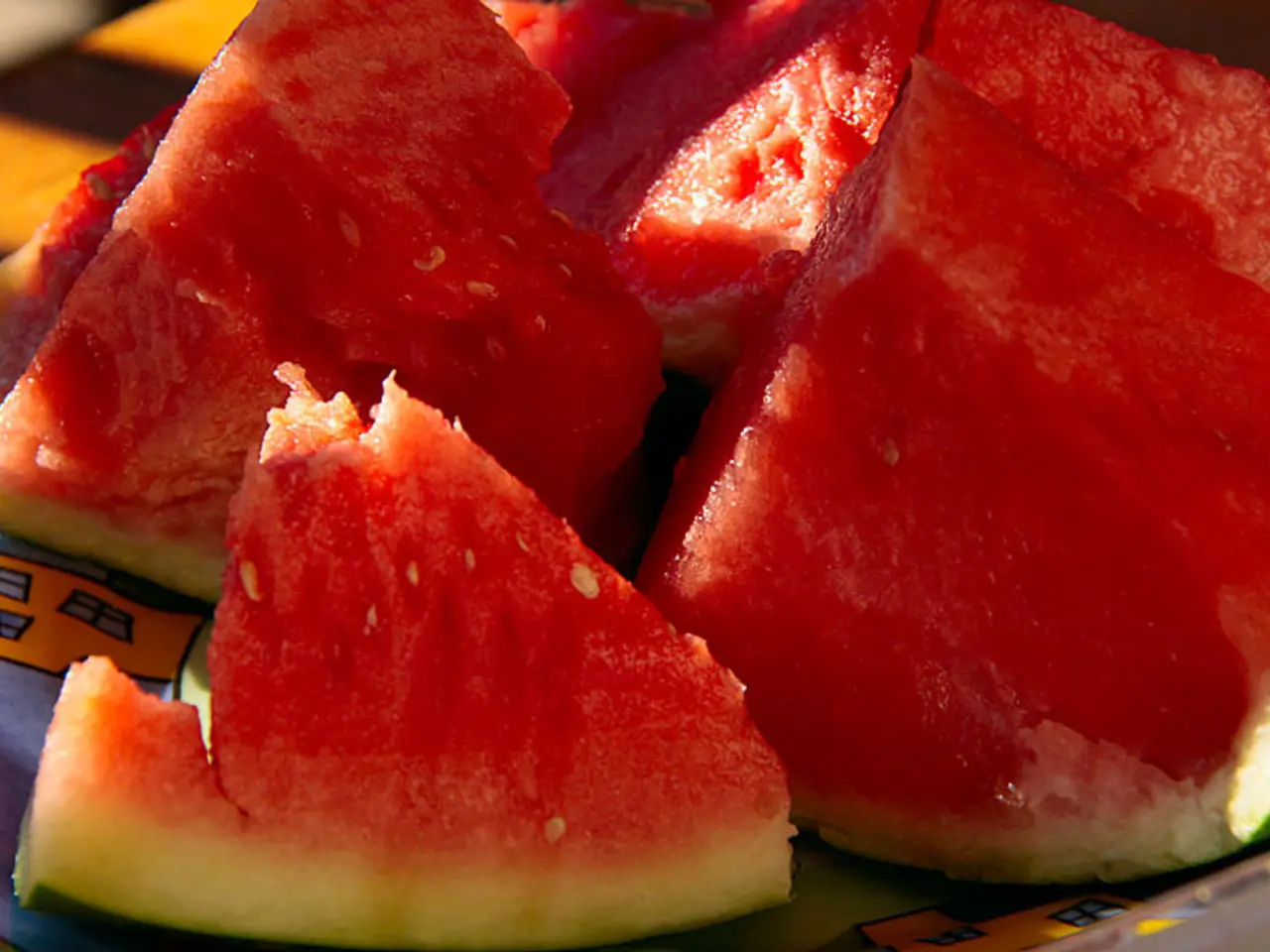Nation celebrates National Watermelon Day, savoring refreshing watermelons amid summer's height
Watermelons, with their juicy sweetness and refreshing taste, have long been a staple of summer gatherings. But did you know that these beloved fruits play a significant role in domestic agriculture and seasonal retail strategy?
In the United States, the watermelon industry is concentrated in southeastern and western states, with Florida, Georgia, California, and Texas leading the way in production. In 2024, these states collectively produced 3.7 billion pounds of watermelons, accounting for approximately 45% of the nation's total production [2][3][4][5].
Florida, in particular, leads the pack, contributing almost one-quarter of the total U.S. production (912 million pounds) [3][5]. California is also noted for its warm climate and fertile Central Valley, which supports its position as a leading producer [5].
However, the watermelon market isn't just limited to domestic production. Imports play a significant role as well, with the majority of watermelons coming from Mexico and Central America. In 2024, watermelon imports reached 1.78 billion pounds, representing 35% of the domestic supply, peaking seasonally in May and October to supplement the domestic growing season [3].
The United States is the largest watermelon importer by value, with imports worth approximately $440 million in 2024 [4]. This reflects a strong domestic watermelon industry complemented by substantial imports mainly sourced from Mexico and Central America [2][3][4][5].
Aside from being a tasty treat, watermelons offer numerous nutritional benefits. They are high in water content, potassium, electrolytes, and antioxidants that help restore balance, protect cells from sun-related stress, and manage oxidative stress in the body. Overripe or leftover watermelon flesh is even used in sorbets and blended drinks.
Watermelon rinds, once considered waste, are now used in a variety of dishes, including coleslaws, stir-fries, chilled soups, pickling, candying, and smoothies. Watermelon seeds are also being roasted as snacks, turned into seed butter, or used as garnish.
The celebration of watermelons extends beyond their consumption. National Watermelon Day, celebrated with watermelon-themed events across America, promotes community gatherings and hometown pride. The Winterville Watermelon Festival in North Carolina, although not on the exact date of National Watermelon Day, still captures the summer vibe with carnival rides, games, live performances, and a watermelon-eating contest.
In Nashville, the Farmers Market hosts a Watermelon Fest later in August, focusing on the fruit with live music, local produce, watermelon-themed snacks, and a kids zone. These festivals not only celebrate the watermelon but also the farmers and growers who make its presence possible.
Finding a ripe watermelon at the grocery store involves checking the ground spot, looking for softening stripes (for striped varieties), fading overall color (for solid green types), and comparing weight. Cooks and chefs are finding inventive ways to reduce watermelon waste, using rinds, seeds, and flesh in various dishes.
In conclusion, the watermelon industry in the United States is a thriving one, with a strong domestic presence complemented by substantial imports from Mexico and Central America. The watermelon's role extends beyond being a refreshing treat, with its nutritional benefits, versatility in food preparation, and significant impact on domestic agriculture and seasonal retail strategy.
References:
- Watermelon: Nutrition Facts and Health Benefits
- Watermelon Production in the United States
- Watermelon Imports in the United States
- United States Watermelon Imports by Value
- California's Role in Watermelon Production
- Nutritionists and health-and-wellness enthusiasts often highlight the nutritional benefits of cooking with watermelons, including its high water content, potassium, electrolytes, and antioxidants.
- In the spirit of sustainable and healthy-cooking, artists and chefs are experimenting with unique recipes that incorporate various parts of the watermelon, such as seeds, rinds, and flesh.
- Watermelons are versatile ingredients not only in food preparation but also in the creation of refreshing drinks, making them prominent in the food-and-drink sector.
- Fitness-and-exercise enthusiasts can even incorporate watermelon into their diets, as its electrolytes and water content can aid in post-workout hydration and recovery.
- As global awareness of health and lifestyle concerns grows, the demand for healthy food options also increases, leading to an increase in the popularity of healthy-cooking with seasonal ingredients like watermelons.
- With a growing interest in global-cuisines worldwide, watermelons, having an intrinsic presence in various countries' traditional dishes, gain recognition as a staple ingredient in international kitchens.
- In fact, watermelon cultivation is a significant contributor to the economy of many countries, such as those in Central America, where the fruit serves as a crucial aspect of their seasonal retail strategy.
- During the summer, watermelons can be found in a variety of kitchens and settings, from family cookouts to high-end restaurants, showcasing the diversity of their usage in the culinary world.
- The popularity of watermelons continues to grow, as they are not only a tasty treat but also a meaningful element in community gatherings, reflected through events such as the Winterville Watermelon Festival and Nashville's Watermelon Fest.
- Chefs, nutritionists, and advocates of health-and-wellness in the food-and-drink industry recognize the crucial role of watermelons in promoting a balanced diet, offering support for overall health, nutrition, and fitness-and-exercise goals.




